
|
KIT: |
Tamiya 1/48 Me-262A-1a |
|
KIT # |
? |
|
PRICE: |
$37.00 |
|
DECALS: |
See review |
|
REVIEWER: |
|
|
NOTES: |
CEC48369 - Me-262
Slats/Flaps/flying Surfaces - US$14.99 |

|
HISTORY |
Following the
victories in the West in 1940, the Reichluffartsministerium (RLM)
decided that any project not capable of coming to fruition within 18 months
would be scrapped, since it would be unlikely to be used in the current
conflict. This effectively put the entire German jet fighter program on hold,
to the ultimate benefit of the Allies when not one German jet
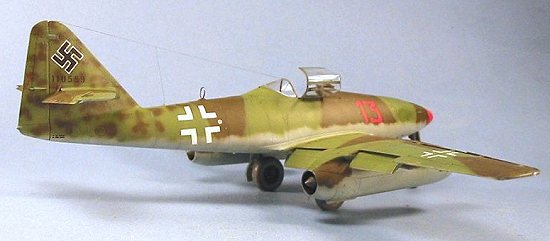 aircraft reached
operational effectiveness in worthwhile numbers. This was particularly fortunate
when one compares the performance of the Me-262 with the Meteor I and III, the
only Allied jet fighter that could have opposed it, had it reached operational
units in early 1944 as Adolf Galland believed it could have. In a post-war
interview, Galland stated, "I believe the Me-262 could have been made
operational as a fighter at least a year and a half earlier, and built in large
enough numbers so that it could have changed the air war. It would most
certainly not have changed the final outcome of the war, for we had already lost
completely, but it would have probably delayed the end, since the Normandy
invasion on June 6, 1944, would probably not have taken place, at least not
successfully if the 262 had been operational. I certainly think that just 300
jets flown daily by the best fighter pilots would have had a major impact on the
course of the air war."
aircraft reached
operational effectiveness in worthwhile numbers. This was particularly fortunate
when one compares the performance of the Me-262 with the Meteor I and III, the
only Allied jet fighter that could have opposed it, had it reached operational
units in early 1944 as Adolf Galland believed it could have. In a post-war
interview, Galland stated, "I believe the Me-262 could have been made
operational as a fighter at least a year and a half earlier, and built in large
enough numbers so that it could have changed the air war. It would most
certainly not have changed the final outcome of the war, for we had already lost
completely, but it would have probably delayed the end, since the Normandy
invasion on June 6, 1944, would probably not have taken place, at least not
successfully if the 262 had been operational. I certainly think that just 300
jets flown daily by the best fighter pilots would have had a major impact on the
course of the air war."
1,420 Me-262s of all variants were produced by the end of the war. Fortunately for history, the words that best describe this technological wonder are "too little, too late."
Heinz Bar:
The leading experte flying the Me-262 in the air-to-air combat role was Heinz Bar, who is tied with Joseph McConnell as the second-ranking jet ace of history. He was also considered the friendliest and most outgoing of the Luftwaffe's experten.
As an air-minded teenager, Heinz Bar took up the sport of gliding and became a qualified pilot of powered aircraft at age of 17, with hopes of flying for Deutsche Lufthansa. Joining the Luftwaffe in 1937, on September 25th, 1939 Feldwebel Bar scored his first victory. a French Hawk 75 over the Western Front. He flew with JG 51 during the Battle of Britain - at first as Werner Moelder's wingman. On July 2nd, 1941, with a score of 27, he was promoted from Feldwebel to Leutnant and awarded the Knight's Cross. On August 14th, 1941, with a score of 60, he was promoted to Oberleutnant and awarded the Oak Leaves to the Knight's Cross. Shortly after, he was shot down 50 kilometers behind the Soviet lines. Despite a double fracture of the spine, he made it back to German territory.
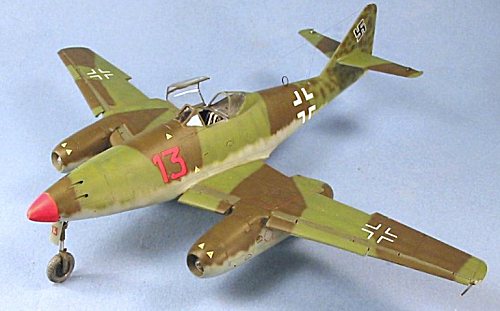 By
February 16th, 1942, Bar - now a Hauptmann with a score of 90 - was
awarded the Swords. Shortly after, he was promoted to Major, and
appointed Geschwader Kommodore of JG 77, which was based in Sicily.
During his time in Sicily and Italy, he suffered from ulcers and malaria while
raising his score to 133 before being invalided back to Germany in late 1943.
His attitude of forthright honesty in an organization whose high command was
thoroughly corrupt earned him Goring's enmity, and he was reduced to
Staffelkapitan with II./JG1 in Holland, the only Major in the
Luftwaffe flying such an assignment. Within a matter of months his score
included several B-17s, and he was appointed Geschwader Kommodore of JG 3 in
Germany. He scored his 200th victory in April 1944.
By
February 16th, 1942, Bar - now a Hauptmann with a score of 90 - was
awarded the Swords. Shortly after, he was promoted to Major, and
appointed Geschwader Kommodore of JG 77, which was based in Sicily.
During his time in Sicily and Italy, he suffered from ulcers and malaria while
raising his score to 133 before being invalided back to Germany in late 1943.
His attitude of forthright honesty in an organization whose high command was
thoroughly corrupt earned him Goring's enmity, and he was reduced to
Staffelkapitan with II./JG1 in Holland, the only Major in the
Luftwaffe flying such an assignment. Within a matter of months his score
included several B-17s, and he was appointed Geschwader Kommodore of JG 3 in
Germany. He scored his 200th victory in April 1944.
In September, 1944, Bar flew the Me-262 for the first time, at Wenzendorf. He was given command of III./EJG 2 at Lechfeld; this unit was what had at one time been the Kommando Nowotny. Messerschmitt obtained his services to test fly the Me-262 for armament development. He helped test both the R4M rocket and the Deichselschlepp - the winged bomb - all the while undertaking combat sorties! Though his responsibility with III./EJG 2 was to train pilots for the Me-262, he claimed 9 further victories with the Me-262, the first being a P-51 on March 19th, 1945.
After Galland was injured in mid-April, Bar assumed command of JV 44, where he scored seven more victories against B-26 Marauders, using the R4M rockets he had helped develop. As one of the few "first to last" experten, Bar's total score was 220, of which 124 were U.S. and British (only 30 fewer than Marseille), including 16 in the Me-262. His score in jets equals that of Capt. Joseph McConnell, Jr., and is only exceeded by that of Col. Yevgeney Pepelyaev (though there may be Israelis with scores in this range or more).
 In combat from the
first day of the war to the last, Heinz Bar completed more than 1,200 missions,
entering combat 825 times. As a comparison, the most active Allied fighter
pilots flew between 250-400 missions; Richard Bong, the American Ace of Aces,
flew 254 missions and opened fire at an enemy target 83 times, scoring 40
victories - and this is the best record of any U.S. pilot. Bar created three
"aces" on the Allied side, having been shot down himself 18 times in the course
of 6 years of combat.
In combat from the
first day of the war to the last, Heinz Bar completed more than 1,200 missions,
entering combat 825 times. As a comparison, the most active Allied fighter
pilots flew between 250-400 missions; Richard Bong, the American Ace of Aces,
flew 254 missions and opened fire at an enemy target 83 times, scoring 40
victories - and this is the best record of any U.S. pilot. Bar created three
"aces" on the Allied side, having been shot down himself 18 times in the course
of 6 years of combat.
In 1950, Bar was placed in charge of sport flying in West Germany. Ironically, he died April 28th, 1957, flying a light aircraft in an aerobatics exhibition. He was only 44.
|
THE KIT |
My own assessment is that I am not impressed with Tamiya's Me-262 kits, at least out of the box. (Heretic! Burn him! :o) Ed) Other than a bit better parts fit, the kit does not offer any real advance over the 24-year old Monogram Me-262. This is particularly so when you realize Tamiya did not provide at least the leading-edge slats - which were always fully-deployed when on the ground - which they were able to do with their Bf-109E kit, as well as the dropped flaps for which their other kits are all famous. One is, therefore, virtually forced to obtain the Cutting Edge resin sets, if you want a "definitive" Me-262 in your collection.
|
CONSTRUCTION |
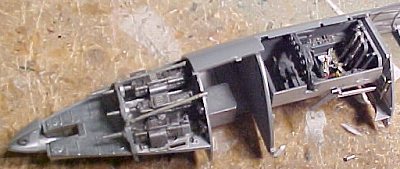 As regards
construction of the basic kit, I read
Scott's review and avoided
the problems he faced in installing the nose weight.
As regards
construction of the basic kit, I read
Scott's review and avoided
the problems he faced in installing the nose weight.
I found, after I had
assembled the 4-gun cannon bay, that it did not fit that easily; this may have
been due to ham-handedness on my part, since the rest of the kit fits together
quite easily. To me, the Me-262 doesn't look that good with the gun bay
open anyway, so I was not terribly upset to remove that and close it up.
You 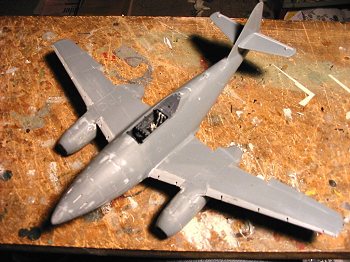 can see from the
accompanying photos that the guns look good.
can see from the
accompanying photos that the guns look good.
To assemble the slats and flaps, you will have to cut off the relevant areas of the wings before assembly. The wing sub-assembly is then glued together. The wing plugs for the slats and flaps fit easily with only a bit of pre-fitting necessary. Using slower-curing cyanoacrylate glue will allow you the time to position them properly once you have glue on them. Steve Mesner has pointed out that the main gear of the kit is "unloaded, with the oleos at maximum extension, which changes the "sit" of the finished model. Per his suggestion, I "loaded" the main gear of the kit by cutting off the oleo, shortening it 1/16 inch, then modifying the oleo scissors accordingly to fit as shown in the accompanying detail photos. As you can see from the photos of the finished model, this really does improve the look, and I recommend you do this with yours. (Your editor surmises that when Tamiya measured museum planes with no fuel on board, this resulted in the more lightly loaded condition of the oleos)
 |
 |
 |
|
PAINT & DECALS |
Painting:
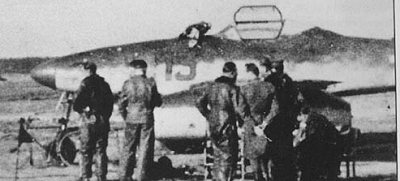 There are several
well-respected kolour experten who say that Bar's airplane was painted in
74/75/76. There are a nearly-equal number who say it was in 81/82/76.
There is only one photograph of Bar's airplane that I am aware of that gives one
a chance to make their own decision, and that is published here.
There are several
well-respected kolour experten who say that Bar's airplane was painted in
74/75/76. There are a nearly-equal number who say it was in 81/82/76.
There is only one photograph of Bar's airplane that I am aware of that gives one
a chance to make their own decision, and that is published here.
This is not a very good photo, which is why I think people have been able to come to both conclusions above as they have. Pete Chalmers, who I consider one of the best "color analysts" around, uses the following method for determining colors of Luftwaffe airplanes from black-and-white photos:
(1) If the two upper colors are fairly pale and low contrast with each other, and black or black-green markings/spinners/propellers are very much darker: "Probably to Most Likely" 74/75
(2) If the two upper colors are fairly dark and low contrast, and the black/black-green areas are only a bit darker: "Probably" 81/83, the darker of the two greens.
(3) If the two upper colors are fairly "contrasty": The lighter color could be 75, primer grey, 77, or 82 (the brighter green), and the darker color could be 74,70,71,74,81, or 83.
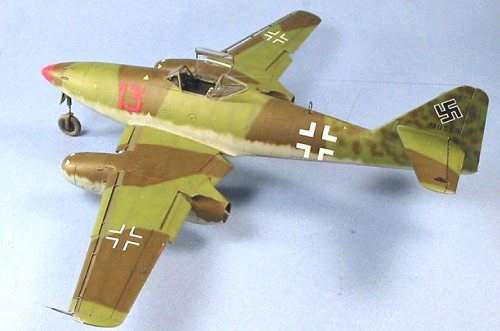 As you can see,
looking at the photo, Rule #3 seems to apply, meaning one could do 74/75/76 or
81/82/76. Jerry Crandall says that Me-262s in this production range were
painted 74/75/76, and one cannot rule this out even if 74 was "officially
discontinued" in June 1944.
As you can see,
looking at the photo, Rule #3 seems to apply, meaning one could do 74/75/76 or
81/82/76. Jerry Crandall says that Me-262s in this production range were
painted 74/75/76, and one cannot rule this out even if 74 was "officially
discontinued" in June 1944.
In the end, after looking at other models and color profiles of Red-13 at the Stormbirds.com website, I went with 81/82/76.
I used Gunze-Sangyo "Olive Drab (1)" for the base color of RLM81, then went over it with a mixture of Gunze "Olive Drab (2)" mixed with some Tamiya "Red-Brown" to fade it. The RLM82 was my own mixture of Gunze greens. The lower surface was painted with Gunze-Sangyo RLM76.
Decals:
I used the very good Eagle Cals sheet that was made to accompany their newly-released book "Stormbird Colors" by Brett Green (EagleFiles #5). Eagle Cals are always excellent, and this sheet was no exception.
|
CONCLUSIONS |
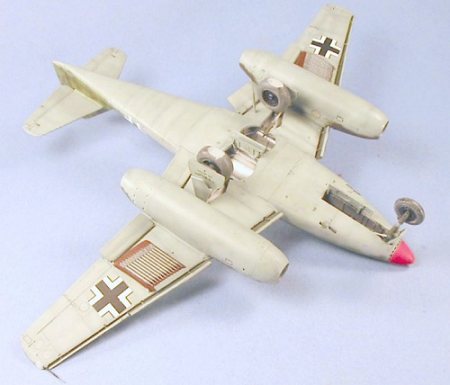 The Tamiya kit is
good. It is easy to assemble and provides a basically good model out of the
box. Given the state of the art of plastic model design and production, it fails
for not providing the slats and flaps as part of the kit. Building the kit with
the Cutting Edge resin sets (which raise a $37 dollar kit to a $69 model)
results in a very good-looking model, but I still consider the kit a failure by
Tamiya in terms of production design. That said, I really like having this
particular model in my collection, next to the models of Bar's "Red-23"
Fw-190A-7, and his "White 13" Bf-109E.
The Tamiya kit is
good. It is easy to assemble and provides a basically good model out of the
box. Given the state of the art of plastic model design and production, it fails
for not providing the slats and flaps as part of the kit. Building the kit with
the Cutting Edge resin sets (which raise a $37 dollar kit to a $69 model)
results in a very good-looking model, but I still consider the kit a failure by
Tamiya in terms of production design. That said, I really like having this
particular model in my collection, next to the models of Bar's "Red-23"
Fw-190A-7, and his "White 13" Bf-109E.
Thanks to Hobby Link Japan for the Review kit.
Thanks to Meteor Productions for the Cutting Edge resin sets.
If you would like your product reviewed fairly and quickly by a site that has well over 175,000 visitors a month, please contact me or see other details in the Note to Contributors.